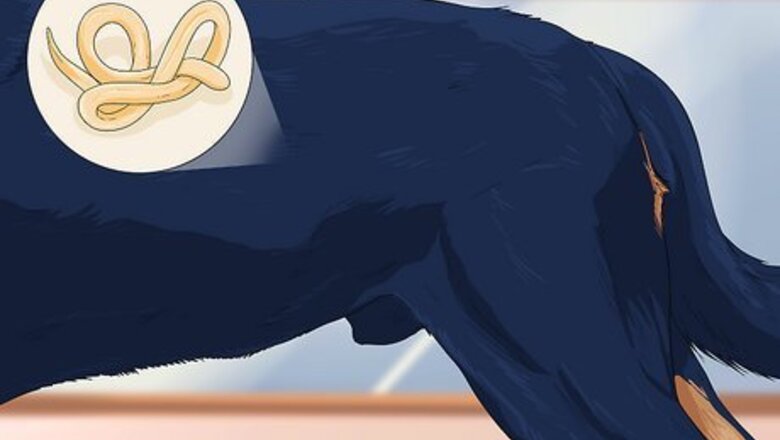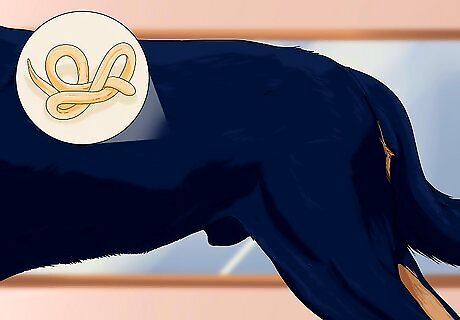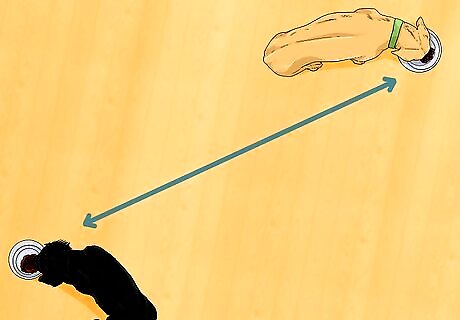
views
Take your dog to a vet to rule out medical problems.

Parasites or chronic illnesses can make your dog eat more quickly. A stomach parasite prevents your dog from getting all the nutrients it needs, so it will try to quickly gulp down its food. Thyroid and hormone issues in older dogs can also prevent them from feeling full so they’ll eat really fast. Reach out to your vet to let them know about the issue and take your dog in to see if there are any underlying causes. When your dog eats too fast and then exercises, it can develop life-threatening bloat, also known as gastric dilatation and volvulus (GDV). If you see your dog has difficulty moving, dry heaves, a round, expanded stomach, or if it pants and salivates excessively, take your dog to a vet immediately.
Use a slow feeder bowl.

Slow feeders spread out food so your dog takes smaller bites. A slow feeder bowl has raised grooves that your dog has to eat around. Spread the kibble evenly throughout the bowl so your pup will only be able to get a few pieces out at a time. Slow feeders are great enrichment for dogs since it challenges them to figure out how to reach their food. Your dog will eat faster as it gets used to using a slow feeder, but it will still be slower than feeding it from a regular bowl.
Fill a puzzle toy with your dog’s food.

Your dog will have to solve small puzzles in order to access its food. Get puzzle toys that have sliding drawers or small compartments where you can hide kibble. Load the food into the toy and give it to your dog to play with. Since your dog has to work to get to the food inside, it won’t be able to eat as fast and will take more time to eat its entire meal. Puzzle toys are great for keeping senior dogs mentally engaged.
Hide dog food in a snuffle mat.

Snuffle mats make your dog find and forage for its food. A snuffle mat has long felt strips where you can hide your dog’s food tied to a rubber mat. Spread the kibble throughout the mat and push the kibble towards the rubber on the bottom. Your dog will sniff around to find and eat all the pieces, and they won’t be able to wolf them down.
Split up meals throughout the day.

Multiple smaller portions stop your dog from eating too much at once. If your dog eats so fast that it chokes or vomits, it’s having too much food in one sitting. Try splitting your pup’s meals into 3 or 4 smaller portions that you feed it during the day to train it to eat slower.
Put a tennis ball in your dog’s bowl.

Your dog will have to move the ball around to reach its food. After you fill your dog’s bowl, set a tennis ball on top of the food. Since the ball blocks some of the food, your dog will have to push the ball out of the way and won’t be able to take as big of bites. If your dog picks the tennis ball out of the bowl, then try putting a large rock in the middle of the bowl instead. Just make sure it’s large enough so that your dog won’t try to eat it. You can also try flipping your dog’s food bowl over and putting the kibble in the ring around the raised center.
Feed your dog from a muffin tin.

Muffin tins force your dog to eat its food in smaller portions. Rather than filling a deep dog bowl with your pup’s entire meal, split it up into quarter portions. Put each portion into a separate cup on the muffin tin. Since your dog will have to stop and move to the next cup to keep eating, it’ll take a little more time to finish its meal.
Spread the kibble out on a cookie sheet.

The dog food will slide around so your dog doesn’t eat in large gulps. Set a cookie sheet on the ground and pour all of your dog’s kibble onto it into a single layer. As your dog eats, it will push the pieces away with its nose and only be able to get a few bits of kibble with each bite. You could instead make a trail of food on a yoga mat. Your dog will love sniffing around for the next bit of food.
Hand-feed your pup.

Hand-feeding lets you control your dog’s portion size with each bite. When it’s time to feed your dog, hold a few pieces of kibble in your hand. Make your dog work for the food by training and practicing commands and rewarding it with the kibble. As your dog gets used to being hand-fed, it will learn to eat slower when you put the food back in its bowl. Taking time to practice commands during mealtime also strengthens your bond with your dog. Take about 15 minutes to feed your dog its full meal so it learns to slow down while it eats.
Add water to your dog’s bowl.

Drinking water before each bite of food helps your dog slow down. Fill the bottom ⁄4–⁄2 inch (0.64–1.27 cm) of the food bowl with water after you put in the kibble. When your dog eats, it’ll lap up some of the water and then chew on the food. Since the kibble floats on the surface, it’ll slosh around so your dog won’t get as much with each bite. Putting water in the bowl also softens your dog’s food, which makes it easier to chew and won’t make your pups choke. Softened food is great for puppies that eat too fast.
Feed your dog away from other pets.

Your dog may eat fast if it’s worried another pet will steal its food. If your dog feels threatened during mealtime, it could eat too fast and lead to choking or vomiting. Find a place for your dog to eat on the other side of the room or in a different room than any other pets you have. That way, your dog can take its time to eat without feeling any competition.



















Comments
0 comment